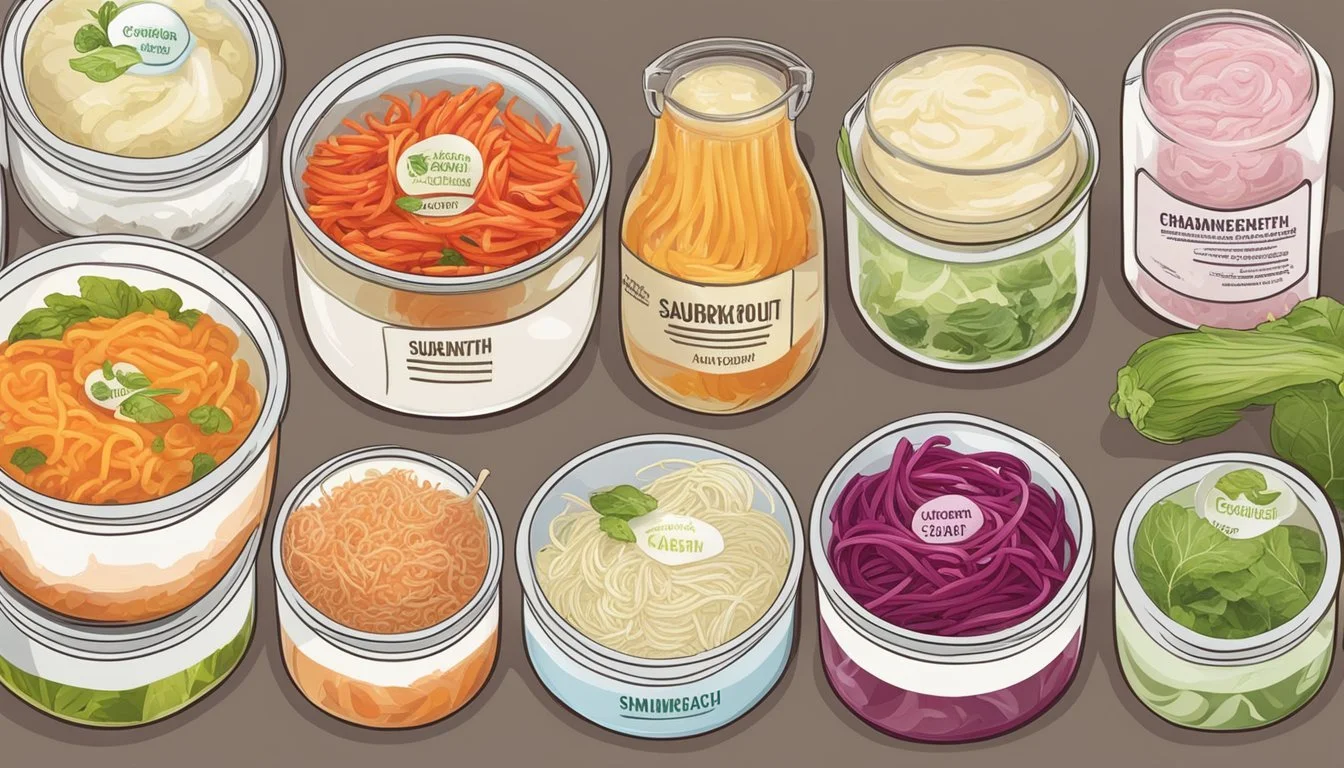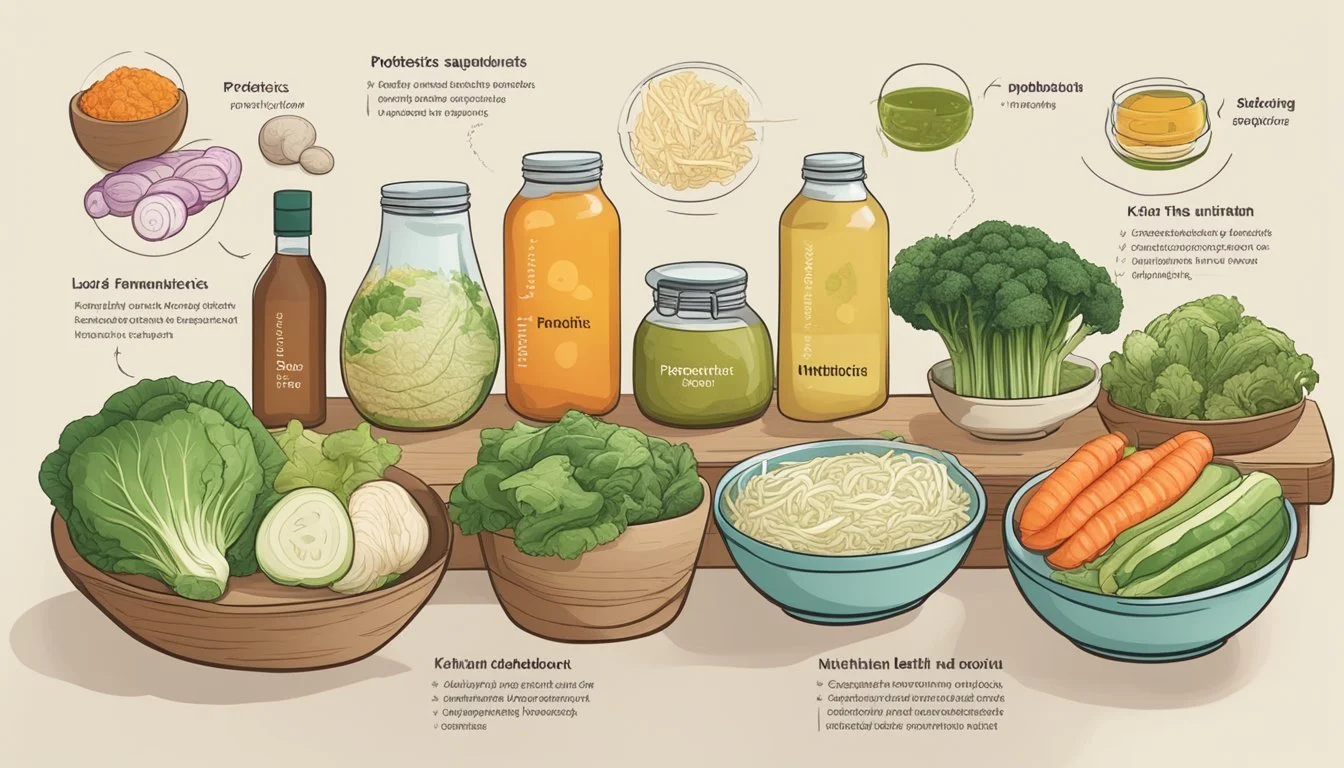What Are the Health Benefits of Food Fermentation at Home?
Uncovering Probiotic Advantages
Food fermentation at home is a traditional practice that has experienced a resurgence in popularity due to its health benefits and the ease of integrating fermented foods (What wine goes well with fermented foods?) into everyday diets. The process involves using beneficial microorganisms to convert carbohydrates into alcohol or organic acids under anaerobic conditions. By doing so, not only is the shelf life of the food extended, but its nutritional value is often enhanced.
One of the key health benefits of consuming home-fermented foods is the introduction of probiotics to the digestive system. These living microorganisms, primarily bacteria and yeasts, contribute to the balance of the gut microbiome, which is crucial for healthy digestion and the immune system. Regular consumption of fermented foods can aid in the absorption of nutrients and may alleviate digestive issues.
Moreover, home fermentation allows individuals to craft and consume foods with fewer additives and preservatives when compared to many commercial products. The process of fermenting at home encourages a hands-on approach to nutrition and facilitates a better understanding of what goes into one's diet. This empowerment through knowledge and practice underscores the value of home food fermentation in fostering a healthier lifestyle.
The Basics of Food Fermentation
Food fermentation is a transformative process that allows natural bacteria and yeast to convert carbohydrates into alcoholic beverages, sour foods, and more. Safety and flavor enhancement are key outcomes of this ancient technique.
Understanding Fermentation
Fermentation is a metabolic process where microorganisms such as bacteria, yeast, and cultures convert sugars and starch into alcohol or acids. This not only preserves the foods but also creates distinctive, complex flavors. The production of lactic acid is especially significant in making foods like yogurt and sauerkraut (how long does sauerkraut last?), as it acts as a natural preservative and can contribute to gut health.
The Role of Salt in Fermentation
Salt is crucial in fermentation for several reasons. It inhibits the growth of undesirable bacteria, thereby allowing the beneficial bacteria to thrive. Salt also helps to draw out moisture, which creates a brine that can protect the fermenting food. In many cases, such as with vegetable ferments, salt concentration can influence both the texture and the speed of fermentation.
Types of Common Fermented Foods
Fermented foods encompass a wide variety of consumables with the presence of beneficial microorganisms, that aid in digestion and offer various health benefits.
Here we list some of the more common choices
Fermented Dairy Products
ranging from dairy products like kefir and yogurt, to
Fermented Vegetables
Fermented vegetables such as sauerkraut and kimchi(how long does kimchi last?),
Fermented grains and legumes
like sourdough bread and dosa.
Health Benefits of Fermented Foods
Fermentation, a process that leverages live cultures to transform food, packs a host of health benefits. This traditional method is esteemed for enhancing gut health through probiotics, fortifying the immune system, aiding in weight management, and having implications for mental health.
Enhancing Digestion
Fermented foods are abundant in probiotics, which are live organisms that replenish the gut microbiome with friendly bacteria.
These beneficial bacteria aid in breaking down food more efficiently, leading to improved digestion. Evidence suggests that if you eat fermented foods you can alleviate issues such as bloating and diarrhea, common symptoms associated with Irritable Bowel Syndrome (IBS).
Boosting the Immune System
A robust gut microbiome is intricately linked to a stronger immune system. The probiotics found in fermented foods act as a defense line, enhancing the body's ability to fight off pathogens. When you eat fermented foods it diversifies the gut flora and provides the body with additional resources to combat infections and reduce the occurrence of illnesses.
Contributing to Weight Loss
Fermentation may play a role in weight management. The presence of probiotics in the gut has been associated with healthier weight levels, as they may influence the metabolism and the body's ability to store fat. Losing weigh has multiple significant health benefits preventing obesity and lowering the risk factors of heart disease and high blood pressure.
Improving Mental Health
Emerging research points to a connection between the gut and mental health, often referred to as the "gut-brain axis." Probiotics from fermented foods may contribute to improved mood and cognitive functions, which could be beneficial for those dealing with depression or stress-related conditions. While the extent of it is still under study, the potential for fermented foods to influence mental well-being is one of the more compelling health benefits of eating fermented foods.
Nutritional Advantages of Fermented Food
While many of the health benefits of eating fermented foods lack sufficient research and are thus still debatable one inarguable health benefit is the nutritional diversity the bring.
The fermentation of foods enhances their nutritional value by improving nutrient bioavailability and contributing to a more balanced diet.
Increased Nutrient Absorption
Nutrient bioavailability is crucial; it determines how much of a particular nutrient the body can absorb. Fermentation breaks down nutrient inhibitors, making minerals like iron and zinc more accessible. For instance, the lacto-fermentation of milk into products like yogurt or kefir reduces lactose, benefiting those who are lactose intolerant and allowing them to enjoy dairy with less discomfort. Additionally, fermented foods often have increased levels of certain B vitamins, crucial for energy metabolism.
Iron Absorption: Food fermentation can reduce compounds like phytates, which hinder iron absorption.
B Vitamins: Fermented foods like sourdough bread may have increased concentrations of B vitamins like folate.
Promotion of a Balanced Diet
Fermented foods contribute to a balanced diet by providing a wider array of nutrients and promoting gut health. They incorporate unique microorganisms that synthesize vitamins and enzymes beneficial to nutrition.
These include vitamin K2 in fermented cheese, which plays a role in bone health and cardiovascular wellness. By adding fermented foods to one's diet, they ensure an intake of diverse nutrients supporting overall health.
Diverse Nutrients: Fermentation can increase vitamin K2 in cheese.
Gut Health: The probiotics found in fermented foods support a healthy digestive system.
Safeguarding Against Diseases
Fermented foods have been linked with reduced risks of several chronic diseases. They contain beneficial bacteria that contribute to a healthier gut microbiome, which is instrumental in disease prevention.
Reducing Heart Disease Risk
The consumption of fermented foods is associated with improved heart health. Probiotics found in these foods can help lower LDL cholesterol and increase HDL cholesterol, which is instrumental in reducing the risk of cardiovascular disease.
Regular inclusion of fermented foods like kefir or kimchi in one's diet may contribute to heart health maintenance.
Managing Diabetes
Type 2 diabetes management may benefit from fermented foods due to their potential to improve blood sugar control. These foods enhance insulin sensitivity and slow down carbohydrate absorption, leading to a more regulated blood glucose level. For individuals seeking to manage diabetes, incorporating fermented dairy products can be a practical dietary adjustment.
Alleviating Inflammation and Allergies
Fermented foods can modulate the immune system, thereby diminishing inflammation and sometimes alleviating symptoms of allergies and autoimmune disorders such as eczema.
Studies suggest that these foods strengthen the intestinal barrier, reducing incidences of leaky gut syndrome, which has been linked to inflammation and autoimmunity.
Regular consumption of fermented vegetables or dairy might aid in controlling inflammation-related diseases.
Food Fermentation at Home: A Practical Guide
Embarking on home fermentation allows one to not only enrich foods with probiotics but also enhance flavors and preserve perishable items.
This section provides key insights into starting the fermentation process at home, choosing suitable ingredients, and addressing common issues that may arise.
Getting Started with Home Fermentation
To begin fermenting at home, one needs to gather necessary tools such as jars, weights, and a cheesecloth.
Recipes may recommend specific equipment or setups based on the food item being fermented. It's essential to maintain a room-temperature environment to facilitate the growth of beneficial bacteria, especially for products like sourdough bread and cheese.
Essential Equipment:
Glass Jars
Non-metallic Weights
Cheesecloth or Fermentation Locks
Optimal Environment: 68-72°F (20-22°C)
Selecting the Right Ingredients
Choosing fresh, high-quality ingredients is crucial for successful fermentation. One should start with organic vegetables or fruits to ensure no unwanted chemicals hinder the fermentation process.
When making pickles or olives, using filtered water prevents chlorine from affecting microbial growth. Apple cider vinegar (how long does apple cider vinegar last?) can be introduced for acidity or as a starter culture in some fermentations.
Common Fermented Foods Checklist:
Organic Vegetables (Beans, Pickles)
Fresh Fruits for Vinegars
Starter Cultures (when necessary)
Purified or Filtered Water
Troubleshooting Common Fermentation Issues
Fermentation might not always go as planned, and it's important to know how to rectify common issues. Mold growth can often be a sign of improper sealing or contamination.
If the ferment smells unpleasant or has an off taste, this could indicate spoilage. Regular checks of fermenting vegetables and ensuring a clean environment counteract such issues.
Troubleshooting Tips:
Sniff Test: Off smells can suggest contamination.
Visual Inspection: Look for unwanted mold or discoloration.
Taste Test: An off-taste can indicate the need to start over.
Fermentation at home offers a broad arena to explore—from crafting tangy sourdough bread to creating crisp pickles. With the correct knowledge and tools, anyone can transform ordinary ingredients into flavorful, probiotic-rich foods.
Cultural Culinary Aspects
From ancient preservation methods to contemporary kitchens, fermentation transforms not only the shelf-life of foods but also enriches culture and flavor profiles across various cuisines.
Global Fermented Food Practices
Globally, fermentation has been a cornerstone in food preservation and preparation. In Germany, sauerkraut is praised for its tangy crispness, a result of lacto-fermented cabbage.
Korea offers kimchi, a staple made from fermented vegetables with a mix of seasonings, engaging taste buds with its complexity.
Japan contributes miso and natto, fermented soybean products that have been traditional sources of umami flavors and essential nutrients.
Yogurt and kefir, fermented dairy staples, enjoy widespread popularity from Eastern Europe to the Middle East. Each culture's unique methods of fermentation highlight its culinary identity and have influenced global food practices.
The Culinary Appeal of Fermented Foods
The allure of fermented foods in culinary applications is two-fold: the introduction of beneficial microbes such as probiotics and a distinctive zest that enriches dishes.
Tempeh (how long does tempeh last?), an Indonesian delicacy made from fermented soybeans, (how long do soybeans last?) offers a nutty flavor and firm texture, ideal for a variety of recipes.
In beverages, kombucha—a fermented tea—and various forms of vinegar and cider provide a refreshing tartness that can be enjoyed directly or used to enhance other dishes.
Baked goods also benefit as sourdough harnesses a natural fermentation process that not only leavens bread but also imparts a unique sour flavor that's become immensely popular.
Olives are another example of fermented food that undergoes a transformative process, yielding a savory product essential in many Mediterranean dishes.
The culinary applications of fermented foods are expansive, and their role in enhancing flavor and nutritional content makes them cherished elements in global cuisine.
Eating fermented foods is a great way to explore other cultures, the Eastern world has far more fermented foods than the Western so traveling abroad and being adventurous with your menu choices is one way to learn and experience less common fermented foods. Of course, if travel isn't on the horizon you could try international food stores.
Environmental and Economic Considerations
Fermenting foods at home offers important environmental and economic benefits. Not only does it contribute to sustainable living practices but also presents a cost-effective alternative to store-bought products.
Sustainability of Food Fermentation
The process of fermenting foods at home plays a significant part in the sustainability movement. It is an effective means of preservation, extending the life of perishable items like pickled vegetables (What wine goes well with pickled vegetables?) and fruits, thus reducing food wastage.
Home food fermentation can utilize local and seasonal produce, minimizing the reliance on transportation and the carbon footprint associated with imported fermented goods. The practice empowers individuals to take part in creating a more sustainable food ecosystem, leveraging a cyclical food system that reduces the impact on the environment.
Promotes the use of seasonal and local produce
Reduces food waste through effective preservation
Decreases reliance on transportation and imported goods
Improves overall digestive health by ensuring you consume more fermented foods
Cost-Effectiveness of Fermenting at Home
Economically, fermenting food at home can be a highly economic practice. Initial costs for necessary equipment are generally low, and many items required such as jars and utensils are commonly found in the average household.
Over time, one can make considerable savings, as homemade fermented food is often less expensive than their store-bought counterparts. Additionally, home fermentation offers the possibility to tailor batch sizes to the consumer's needs, which can further prevent overspending and reduce waste.
Low startup costs and reusability of equipment
Savings over time compared to purchasing commercially fermented goods such as shop-bought sourdough bread and pickles.
Ability to tailor batch sizes to personal consumption needs






